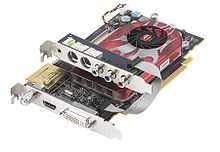All-in-Wonder
| Release date | 1996–2006, 2008 |
|---|
The All-in-Wonder (also abbreviated to AIW) was a combination graphics card/TV tuner card designed by ATI Technologies. It was introduced on November 11, 1996.[1] ATI had previously used the Wonder trademark on other graphics cards, however, they were not full TV/graphics combo cards (EGA Wonder, VGA Wonder, Graphics Wonder). ATI also makes other TV oriented cards that use the word Wonder (TV Wonder, HDTV Wonder, DV Wonder), and remote control (Remote Wonder). The All-in-Wonder line debuted with the Rage chipset series. The cards were available in two forms, built by third-party manufacturers (marked as "Powered by ATI") as well as by ATI itself ("Built by ATI").
Each of the All-in-Wonder Radeon cards is based on a Radeon chipset with extra features incorporated onto the board. AIW cards run at lower clock speeds (two exceptions are the AIW 9600XT/AIW X800XT faster/same speed) than their conventional counterparts to reduce heat and power consumption.[2] In June 2008, AMD revived the product line with an HD model.[3]
Accessories

The cards use a variety of specialised ports along the side to provide output to televisions, with the retail version provided with composite ports and the ability to output to component. Later products also comes with a Remote Wonder remote control and a USB RF receiver to receive radio frequency signals from the remote. Some variants of the All-in-Wonder included FM radio tuning as well. Some analog-based tuners were bundled with Gemstar's Guide Plus+ electronic program guide for TV listings, while digital-based tuners used TitanTV instead.
Drivers
The AIW card drivers are based on ATI's Catalyst drivers with additional T200 unified stream drivers. Currently, the only operating systems fully supporting TV capture with these cards are Microsoft Windows XP, 2000, 98, and 95. Display drivers work on Linux, and TV capture is supported on some cards with the GATOS project.[4]
Lineup
| Retail name | Chipset based on | Variants | Digital/analog signal | AVIVO | Available interface | Introduction date[5][6] |
|---|---|---|---|---|---|---|
| All-in-Wonder HD[7] | Radeon HD 3650 | (Generic only) | Digital/analog | Yes | PCI Express 2.0 | June 26, 2008 |
| All-in-Wonder X1900[8] | Radeon X1900 | (Generic only) | Digital/analog | Yes | PCI Express | January 24, 2006 |
| All-in-Wonder X1800 XL[9] | Radeon X1800 XL | Digital/analog | Yes | PCI Express | November 21, 2005 | |
| All-in-Wonder 2006 PCI Express[10] | Radeon X1300 | (Generic only) | Digital/analog | Yes | PCI Express | December 22, 2005 |
| All-in-Wonder X800 | Radeon X800 | GT (PCI-E only), XL,[11] XT [12] | Analog(/digital on GT) | No | PCI Express, AGP | September 9, 2004 (XT) |
| All-in-Wonder X600 Pro [13] | Radeon X600 Pro | Analog | No | PCI Express | September 21, 2004 | |
| All-in-Wonder 9800 | Radeon 9800 | SE, Pro [14] | Analog | No | AGP | April 7, 2003 |
| All-in-Wonder 9700 | Radeon 9700 Pro | Regular,[15] Pro [16] | Analog | No | AGP | September 30, 2002 February 25, 2003 (Europe, Pro variant) |
| All-in-Wonder 9600 | Radeon 9600 | XT,[17] Pro,[18] Regular[19] | Analog | No | AGP | August 5, 2003 (Pro) January 6, 2004 (Regular, XT) |
| All-in-Wonder 2006 Edition[20] | Radeon 9600 | Analog | No | AGP | Unknown | |
| All-in-Wonder 9200 | Radeon 9200 | Analog | No | AGP, PCI | January 26, 2004 | |
| All-in-Wonder 9000 Pro [21] | Radeon 9000 Pro | Analog | No | AGP | March 31, 2003 | |
| All-in-Wonder Radeon 8500 | Radeon 8500 | Regular,[22] 128MB, DV [23] | Analog | No | AGP | August 30, 2001 (DV) |
| All-in-Wonder Radeon 7500 [24] | Radeon 7500 | Analog | No | AGP | January 22, 2002 | |
| All-in-Wonder VE [25] | Radeon 7500 | Analog | No | PCI | December 2, 2002 February 25, 2003 (Europe) | |
| All-in-Wonder Radeon [26] | Radeon 7200 | Analog | No | AGP, PCI | July 31, 2000 | |
| All-in-Wonder 128 [27] | 3D Rage 128 | Regular, Pro | Analog | No | AGP, PCI | January 25, 1999 |
| All-in-Wonder Pro [28] | 3D Rage Pro | Analog | No | AGP, PCI | October 20, 1997 | |
| All-in-Wonder [29] | 3D Rage II+ | 2MB, 4MB | Analog | No | PCI | November 11, 1996 |
See also
- ATi Wonder Series
- Comparison of ATI Graphics Processing Units
References
- ↑ "ATI's All-in-Wonder brings the seven wonders of graphics acceleration to one mainstream-priced board" (Press release). ATI Technologies. 1996-11-11. Retrieved 2007-11-10.
- ↑ ATI's All-In-Wonder X1900 graphics card - The Tech Report Review - by Scott Wasson — 5:00 AM on January 31, 2006
- ↑ AMD smells a comeback with ATI All-in-Wonder HD - Engadget - AMD announces ATI-all-in-wonder-hd (by Darren Murph, posted Jun 26th 2008 at 12:01AM)
- ↑ GATOS project
- ↑ Investor Relations - ATI Archived News Releases
- ↑ Investor Relations - ATI Archived News Releases
- ↑
- ↑ All-in-Wonder X1900
- ↑ All-in-Wonder X1800 XL
- ↑ All-in-Wonder 2006 PCI Express
- ↑ http://ati.amd.com/products/radeonx800/aiwx800x/
- ↑ All-in-Wonder X800 XT
- ↑ All-in-Wonder X600 PRO - Overview
- ↑ All-in-Wonder 9800 PRO
- ↑ All-in-Wonder 9700
- ↑ All-in-Wonder 9700 PRO
- ↑ All-in-Wonder 9600 XT
- ↑ All-in-Wonder 9600 PRO
- ↑ All-in-Wonder 9600
- ↑ All-In-Wonder 2006 Edition
- ↑ All-in-Wonder 9000 PRO
- ↑ All-in-Wonder Radeon 8500
- ↑ All-in-Wonder Radeon 8500DV
- ↑ All-in-Wonder Radeon 7500
- ↑ All-in-Wonder VE
- ↑ All-in-Wonder Radeon
- ↑ All-in-Wonder 128
- ↑ All-in-Wonder PRO
- ↑ All-in-Wonder
External links
- ATI Multimedia Products page
- TechPowerUp Database of GPUs
- General ATI TV and Overlay Software (GATOS) - open-source Linux suite for All-in-Wonder cards
| ||||||||||||||||||||||||||||||||||||||||||||||||||||||||||||||